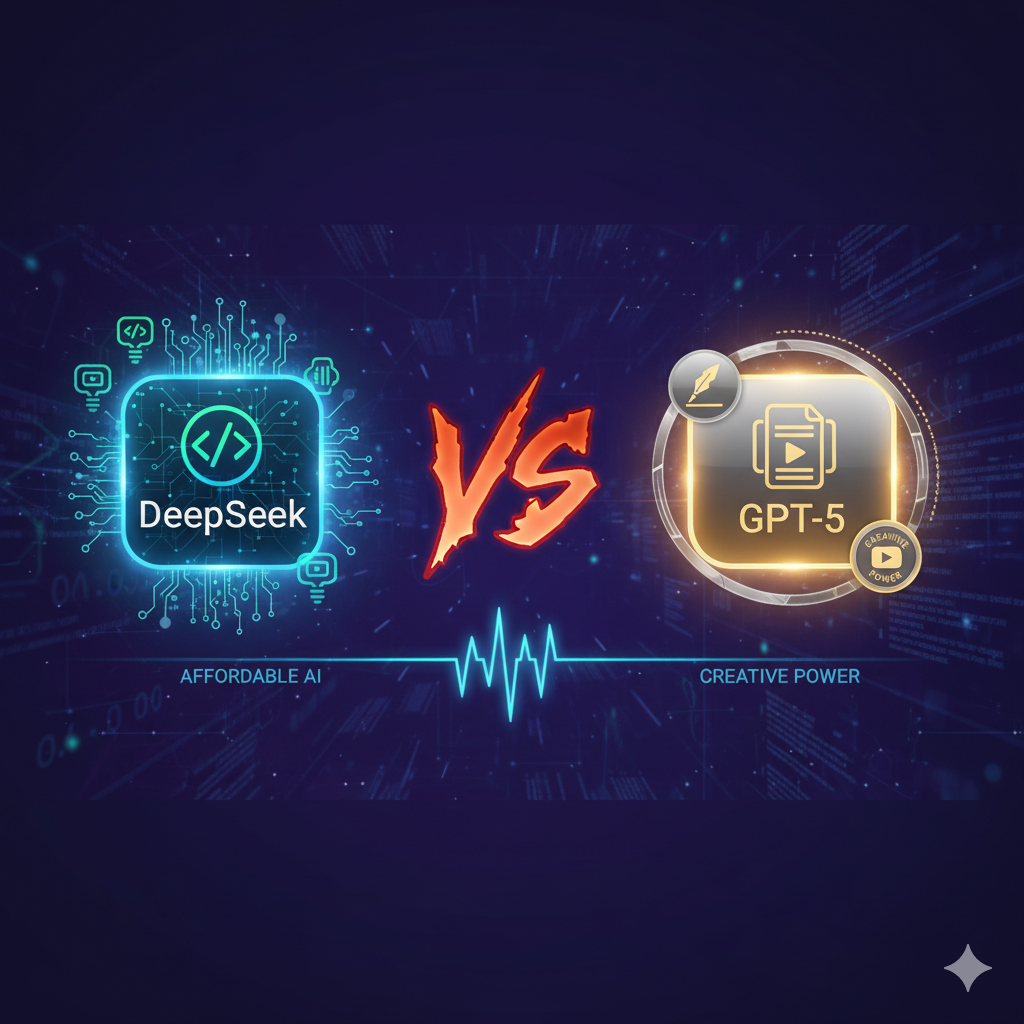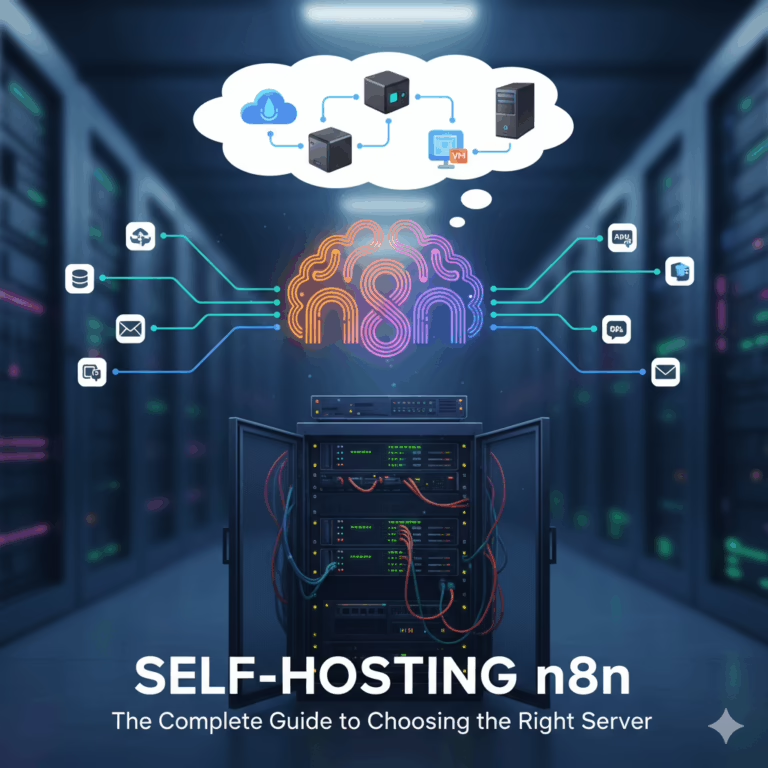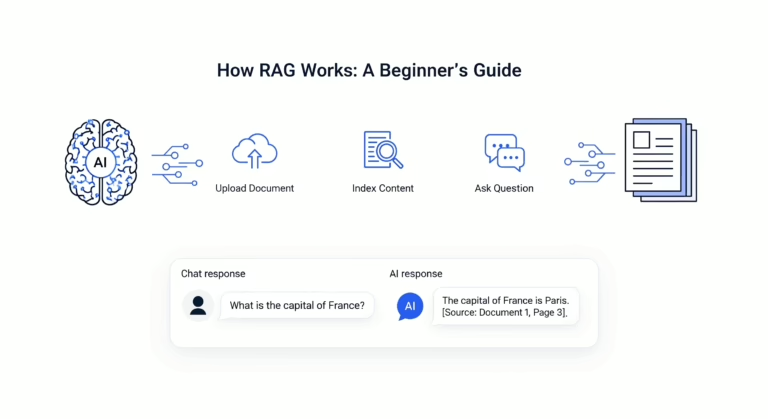Introduction
The definitive DeepSeek vs GPT-5 comparison is essential for every blogger in 2025 looking to leverage artificial intelligence. The content creation landscape is dominated by powerful AI assistants, but the choice between these two leading models represents a critical decision that impacts your workflow, content quality, and budget. This isn’t just a technical comparison; it’s a practical guide to choosing your primary content creation partner.
OpenAI’s GPT-5 arrives as a unified, intelligent system designed to be your ultimate writing collaborator. In the other corner, DeepSeek has made waves with its “blockbuster” open-model approach, offering a hybrid reasoning system that delivers stunning performance at a fraction of the cost. The DeepSeek vs GPT-5 debate ultimately centers on whether you prioritize premium polish and integration or unparalleled cost-efficiency and methodical depth.
As a blogger, you need more than just raw intelligence—you need practical utility, reliability, and cost-effectiveness. This comprehensive DeepSeek vs GPT-5 guide will dissect both models across the dimensions that matter most for content creation. We will provide a clear verdict on which AI model truly deserves a place in your toolkit, whether you’re a solo blogger watching expenses or part of a content team needing top-tier performance.
Table of Contents
What Bloggers Need from an AI Writing Assistant
Before diving into our specific DeepSeek vs GPT-5 analysis, it’s crucial to understand the core requirements bloggers have for AI assistants. The ideal model should excel across several key dimensions:
- Content Quality and Originality: The ability to generate engaging, well-structured, and original content that resonates with your target audience while maintaining a consistent brand voice.
- SEO Optimization Capabilities: Built-in understanding of search engine optimization principles, including keyword integration, meta description creation, and content structuring for better search visibility.
- Workflow Efficiency: Features that streamline the content creation process, from research and outlining to drafting and editing, saving valuable time.
- Cost-Effectiveness: Affordable pricing that aligns with the typical blogger’s budget, especially important for those producing content regularly.
- Ease of Use: An intuitive interface that requires minimal technical expertise, allowing bloggers to focus on content rather than complex tool navigation.
Understanding these needs provides the framework for our DeepSeek vs GPT-5 comparison, ensuring we focus on what truly matters for content creators rather than abstract technical benchmarks.
Meet the Contenders: DeepSeek and GPT-5
GPT-5: OpenAI’s Flagship Model
GPT-5 represents OpenAI’s most advanced AI system to date, launched as a “significant leap in intelligence” over previous models. It’s designed as a unified system that intelligently routes queries between a fast-response model for simple questions and a deeper reasoning model (GPT-5 thinking) for complex problems.
For bloggers, GPT-5 promises enhanced capabilities in three key areas: writing, coding, and health content. OpenAI claims it’s their “most capable writing collaborator yet,” able to help transform rough ideas into compelling writing with “literary depth and rhythm”. The model shows particular strength in handling structurally ambiguous writing forms and maintaining expressive clarity.
GPT-5 is available through OpenAI’s API and ChatGPT interface, with tiered access based on subscription levels. Plus subscribers receive basic access, while Pro subscribers get extended reasoning capabilities for more comprehensive answers.
DeepSeek V3.1/R1: The Cost-Efficient Powerhouse
DeepSeek V3.1 emerged in mid-2025 as a formidable open-weight alternative to established models, making the DeepSeek vs GPT-5 discussion so compelling. This hybrid reasoning model operates in dual modes: a fast “Non-Think” mode for straightforward tasks and a “Deep Thinking” mode (“deepseek-reasoner” in API) for complex reasoning needs.
What makes DeepSeek particularly interesting for bloggers is its architecture. Despite scaling to 685 billion parameters, it uses a mixture-of-experts design that activates only about 37 billion parameters per inference, making it remarkably efficient. The model boasts a 128K token context window, allowing it to process entire books or extensive codebases in a single go.
Perhaps most notably, DeepSeek has gained attention for its exceptional price-performance ratio. Independent evaluations found it could deliver results comparable to top models at roughly 68 times cheaper than alternatives like Claude 4. This cost advantage makes it particularly appealing for bloggers operating on limited budgets and is a central point in the DeepSeek vs GPT-5 value analysis.
Head-to-Head Comparison: Key Factors for Bloggers
Writing Quality and Style Adaptation
GPT-5’s Writing Strengths
In the DeepSeek vs GPT-5 writing quality assessment, GPT-5 positions itself as a premium writing collaborator, demonstrating particular strength in creative expression and adapting to different stylistic requirements. In comparative tests, GPT-5-generated content often shows more polished narrative flow and cultural understanding. For instance, when asked to explain complex topics to specific audiences, GPT-5 demonstrated better judgment in tailoring its explanations appropriately.
The model excels at maintaining consistent tone and rhythm throughout longer pieces, which is valuable for bloggers working on extended articles or serial content. OpenAI’s emphasis on reducing hallucinations (reportedly ~45% less than GPT-4o with web search) means generated content is more reliably factual—a crucial consideration for bloggers building credibility with their audience.
DeepSeek’s Writing Approach
DeepSeek takes a more methodical approach to writing tasks, which defines its position in the DeepSeek vs GPT-5 matchup. While it may sometimes lack GPT-5’s conversational polish, it compensates with thoroughness and structural clarity. In testing, DeepSeek consistently provided more detailed, step-by-step explanations and demonstrated stronger performance in instructional and educational content.
For bloggers who prioritize comprehensive coverage and logical structure over stylistic flair, DeepSeek’s approach may be preferable. Its responses tend to be more exhaustive, anticipating follow-up questions and providing implementation guidance that’s immediately actionable.
SEO Capabilities and Content Optimization
Keyword Optimization and Content Structuring
Both models demonstrate competence in basic SEO principles, but they approach content optimization differently. In our DeepSeek vs GPT-5 SEO testing, GPT-5 tended to produce more naturally integrated keyword usage, weaving terms seamlessly into content without compromising readability. DeepSeek often provided more explicit SEO guidance, including specific recommendations for header structure and keyword placement.
Meta Description and Snippet Generation
For crafting compelling meta descriptions—those critical ≤160-character summaries that appear in search results—GPT-5’s conciseness and flair for engaging language give it an edge in the DeepSeek vs GPT-5 comparison. However, DeepSeek’s methodical approach often yielded more comprehensive options, providing multiple variations for A/B testing.
Table: SEO Capability Comparison
| Feature | GPT-5 | DeepSeek |
|---|---|---|
| Keyword Integration | Natural and seamless | Explicit and structured |
| Content Outline Quality | Creative and engaging | Comprehensive and logical |
| Meta Description Creation | Concise and click-worthy | Multiple variations provided |
| Readability Optimization | Excellent flow and scannability | Strong structural clarity |
Practical Workflow Integration
Content Planning and Research
For bloggers, the research phase is just as important as the writing itself. GPT-5’s integration with web search (when enabled) provides access to current information, though the depth of research can sometimes prioritize breadth over specificity. DeepSeek’s longer context window (128K tokens) enables more comprehensive analysis of source materials, making it particularly strong for technical or data-heavy blogging niches—a key differentiator in the DeepSeek vs GPT-5 workflow analysis.
Drafting and Editing Efficiency
In practical DeepSeek vs GPT-5 tests, GPT-5 typically generates content more rapidly, with better initial polish that requires less editing. DeepSeek may take slightly longer, especially in “deep thinking” mode, but often produces more thoroughly considered drafts that need minimal revision. This trade-off between speed and comprehensiveness represents a key decision point for bloggers with different workflow preferences.
Cost Analysis and Budget Considerations
This is where DeepSeek presents a compelling advantage in the DeepSeek vs GPT-5 debate, particularly for budget-conscious bloggers. Independent analyses consistently highlight DeepSeek’s exceptional price-to-performance ratio. One evaluation noted that running an entire suite of coding tests with DeepSeek cost approximately $1 in compute, compared to “dozens of dollars” for comparable models.
For bloggers producing content regularly, these cost differences quickly compound. A solo blogger generating 5-10 articles weekly might find DeepSeek 5-10 times more cost-effective than GPT-5 over a month. This financial advantage allows for scaling content production without proportional increases in AI-related expenses and is perhaps the most significant factor in the DeepSeek vs GPT-5 decision for many content creators.
Table: Cost and Accessibility Comparison
| Factor | GPT-5 | DeepSeek |
|---|---|---|
| Pricing Model | Tiered subscription (Plus/Pro) | Pay-per-use, significantly cheaper |
| Cost Example | Higher premium for advanced features | ~68x cheaper than some alternatives |
| Open Access | Limited API access | Open-weight model available |
| Self-Hosting | Not available | Possible with sufficient hardware |
Real-World Blogging Scenarios: Which Model Performs Better?
Scenario 1: The Quick-Turn Blog Post
When you need to capitalize on a trending topic quickly, GPT-5’s speed and polish give it the edge in this DeepSeek vs GPT-5 scenario. Its ability to generate publishable-quality content with minimal editing helps you beat publication deadlines while maintaining quality standards.
Scenario 2: The Comprehensive Guide
For long-form, authoritative content requiring depth and accuracy, DeepSeek’s methodical approach and longer context window make it superior. Its step-by-step reasoning ensures comprehensive coverage without oversimplifying complex topics, winning this specific DeepSeek vs GPT-5 use case.
Scenario 3: SEO-Focused Commercial Content
When creating content specifically designed to rank for competitive keywords, GPT-5’s more natural language integration often produces content that satisfies both search algorithms and human readers simultaneously, giving it the advantage in this DeepSeek vs GPT-5 comparison.
Scenario 4: Technical or Tutorial Content
For tutorials, how-to guides, or technical explanations, DeepSeek’s instructional approach—verified in teaching scenarios—yields more actionable and reliable content that readers can successfully implement, making it the clear winner in this DeepSeek vs GPT-5 assessment.
Scenario 5: Budget-Constrained Content Production
For bloggers watching expenses or producing content at scale, DeepSeek’s dramatic cost advantage makes it the clear winner in this DeepSeek vs GPT-5 scenario, offering comparable quality at a fraction of the price.
The Verdict: Which AI Model Should Bloggers Choose?
Choose GPT-5 if…
- Budget is less constrained and you prioritize premium features
- Your content relies heavily on creative storytelling and engaging narrative
- You need quick turnaround times for time-sensitive topics
- Your audience values polished writing and cultural relevance
- You work with multiple content types requiring versatile AI assistance
Choose DeepSeek if…
- Cost-effectiveness is a primary concern in your content strategy
- Your niche requires methodical, detailed explanations (e.g., technical, educational)
- You produce long-form, comprehensive content that benefits from extended context
- You prefer transparent, open-weight models over proprietary systems
- Your workflow involves complex problem-solving and structured planning
Conclusion: The Future of AI-Assisted Blogging
The DeepSeek vs GPT-5 competition represents a healthy maturation of the AI landscape, offering bloggers meaningful choices based on their specific needs rather than one-size-fits-all solutions. While GPT-5 delivers premium performance and polish, DeepSeek’s combination of high capability and remarkable affordability makes advanced AI assistance accessible to a broader range of content creators.
What’s particularly exciting for bloggers is that both models continue to evolve. GPT-5’s unified system architecture promises more seamless intelligent routing between different task types, while DeepSeek’s open approach encourages innovation and customization. This DeepSeek vs GPT-5 dynamic ultimately benefits content creators, driving improvements in both capability and affordability.
The ideal solution for many bloggers might actually involve using both models strategically—employing GPT-5 for creative, audience-facing content while leveraging DeepSeek for research-intensive or technical pieces. As both platforms continue developing, the most successful bloggers will be those who remain adaptable, continuously evaluating how these powerful tools can enhance their unique content creation process. The DeepSeek vs GPT-5 decision isn’t necessarily permanent; it’s about choosing the right tool for your current needs and being willing to reassess as both technologies advance.




